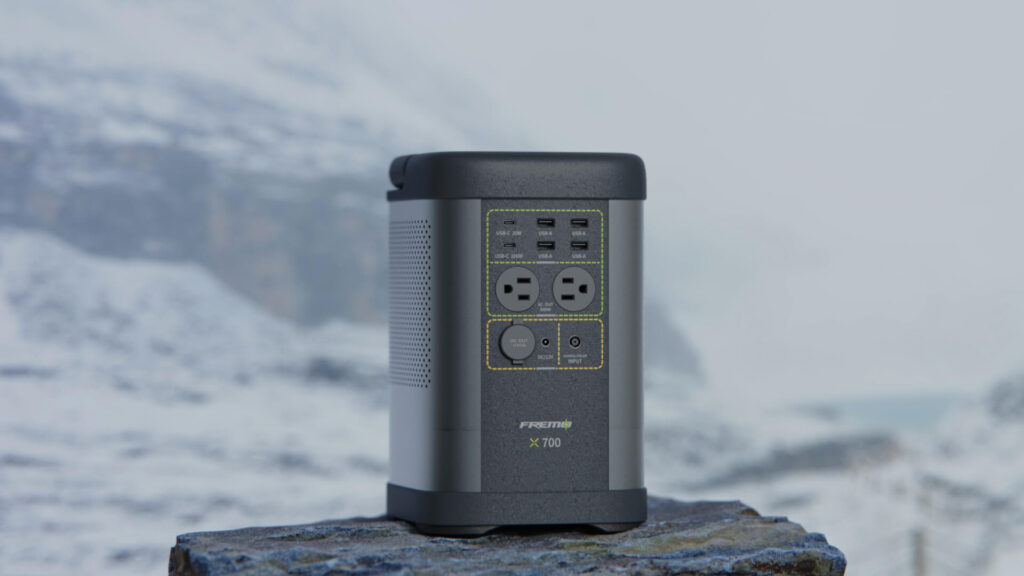How Does a Solar Power Station Work?
Solar generators, like our Fremo X700, are a great backup power source for all kinds of outdoor trips.
They are lightweight and portable, allowing you to charge and run a variety of electronic devices from renewable energy sources.
Plus, they’re environmentally friendly and, unlike traditional generators, it doesn’t require you to have a lot of fuel on hand.
With all that said, the question remains: How exactly does a solar generator work?
Solar generators work by collecting solar energy through solar panels and then storing that energy into their built-in solar cells. The inverter then converts this energy into alternating current (AC) which is then released for use in household appliances and other electronic devices. When combined, the three components form a fully functional solar generator.
What is a solar generator?

Ultimately, the term solar generator can refer to virtually any technology that can be powered by solar energy.
Most commonly, however, when people use the term solar generator, they are usually referring to portable power stations, like the ones we have for sale at Fremo X700.
These particular systems are capable of capturing solar energy through integrated solar panels, and then transferring said energy to an internal storage system (which usually consists of lithium-ion technology).
Solar generators may not always be suitable for large residential setups, but they are useful for boats, campers, or as an emergency backup in case of a power outage in your area.
How does a solar generator work?
Solar generators can provide consistent off-grid energy over a long period of time, requiring nothing more than solar power.
Solar generators offer a green solution to power generation that in many cases is as effective as or more efficient than propane or gas-fired generators.
Solar generators work by integrating solar panels, charging controllers, battery systems and inverters into a compact system capable of converting solar energy into useable current.
To better understand how solar generators work, we will discuss each of their components separately.
Battery: The solar generator needs to store the energy it collects from the sun so that you can use it later. The battery acts as a storage unit.
Lithium-ion batteries have been used in a variety of solar generators on the market since around 2016. However, you can also use less efficient lead-acid batteries, which are cheaper and more plentiful than lithium-ion technology.
That said, lithium-ion batteries do offer significant advantages over lead-acid batteries, and we recommend using them because they are safer and more affordable in the long run.
Charge controller: An important part of a solar generator, its main purpose is to protect and promote the durability of the batteries. Charge controllers usually have various functions for charging and discharging depending on the particular type of battery and solar panel combination you are using.
Charge controllers are critical to the operation of solar generators because they balance the power dynamics between the solar panels and the batteries.
Inverter: This component converts the low direct current (DC) from the batteries into alternating current (AC), which can be used to power your everyday household appliances.
Appliances that require DC power can actually be used without an inverter, as there is no need to convert the power.
You can read this article to learn more about the difference between AC and DC power.
Why are solar generators essential?
It is becoming increasingly important for everyone to have backup power at home because as more and more people rely on these technologies each year to survive and stay connected to the rest of the world.
Solar generators are used not only to power small appliances such as fans, medium-sized refrigerators and air conditioners, but also to provide essential backup power for critical medical equipment such as CPAP machines and other home health monitors.

Top 5 benefits of using a solar generator
1.Free clean energy from the sun
When you use a solar generator, you’re actually using free energy from the sun instead of expensive, dirty fossil fuels. You can continue to get this free energy from the sun for the life of the solar panels, which is usually about 25 to 30 years.
2.Low maintenance cost
Unlike most traditional fuel or gas generators, solar generators have absolutely no moving parts and do not use liquid fuel. The lack of moving parts means you are much less likely to have to pay for any type of repairs.
3.Quiet and clean operation
In addition to the obvious economic benefits of using solar generators, there are various environmental advantages to choosing this green technology over other fossil fuel systems. Gas generators cause air and noise pollution, and while the latter is merely annoying, the former contributes to climate change.
4.It’s an investment opportunity
Solar panels have a total lifetime of 25 to 30 years. While gas generators do have a long life span, usually 20 to 40 years, they are not without problems. You will need to perform various maintenance tasks on them to keep them running properly. In addition, you will need to keep buying fuel for them in order to use the equipment. Solar generators do not require such tasks.
5.Light
Most heavy-duty gas generators weigh a lot, sometimes as much as 250 pounds. In contrast, our heavy-duty solar Fremo X700 weighs just 17.4 pounds. Obviously, the less powerful a generator is, the lighter it usually is, but all in all, solar generators are much lighter than gas generators.
